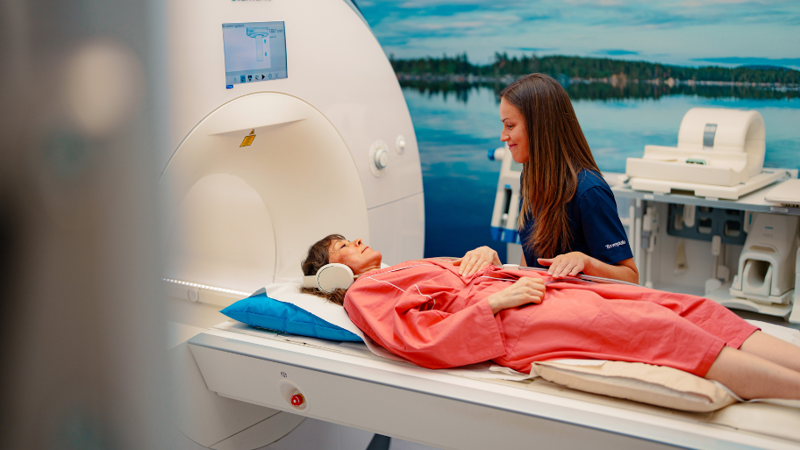Näin Suomi voi - a review of the health of working-age people
In 2023, Finland returned to pre-Covid19 levels of morbidity. However, Terveystalo's data on "Näin Suomi voi (How Finland is doing)"* reveals a significant change in the nature of sickness absence, which reflects a change in the culture of work performance management and a change in the way work is done. Despite the decline in sickness absence rates, the poor general health of the working-age population is a cause for concern for health professionals.

In general, the number of sick leave cases fell significantly. In 2023, the average number of days of sick leave per person was 10, 15% less than in 2022.
– Up to 42% of all workers remained healthy throughout the year and were not absent from work due to sickness in 2023. Although 2023 seemed to start with a spike in absenteeism due to infections, over the year as a whole, respiratory infection morbidity fell back to normal levels for the first time since the interest rate years, in line with the above-mentioned figure known as the health percentage. This is also reflected in the number of days of sickness absence related to coronary infection, which was up to 88% lower than in 2022," says Maaret Helintö, senior physician in charge of development at Terveystalo.
Already almost half of short sickness absences of between 1 and 3 days are granted by supervisors
Terveystalo's sickness absence summary includes both absences granted at Terveystalo's occupational health department and absences granted outside Terveystalo. The data shows that the culture of work capacity management in Finland has changed permanently, as it is increasingly possible to be sick at home with the permission of a front-line employee for mild symptoms.
– This cultural change has been rapid, accelerated by the Covid19 epidemic, with the vast majority of our clients now already authorising supervisors to grant short absences. In our clients' experience, the overall duration of absences is reduced when they can be negotiated flexibly, for example on a day-by-day basis, between the supervisor and the employee, depending on their condition. This approach requires trust between the supervisor and the employee, and new leadership skills from the supervisors," says Silja Komulainen, deputy general practitioner at Terveystalo's occupational health department.
– From a health care perspective, the stronger role of frontline workers in granting absence will increase the effectiveness of occupational health by shifting the work of professionals from treating self-healing illnesses, such as flu viruses, and granting sick leave to supporting and maintaining the well-being and work capacity of employees," adds Helintö.
In late 2023, Terveystalo introduced a new customer care model using a CE-marked medical device, the Symptom Assessment Tool, in digital channels. This has contributed to the uptake of self-reporting.
– After analysing the answers provided by the client and assessing the urgency of treatment based on symptoms, the Self-Assessment tool first reminds the client of the self-reporting policy, if one is in place in the organisation. Doing so supports a cultural change and frees up professional time for those who need it most urgently," says Komulainen.
Absences due to musculoskeletal disorders continue on a downward trend
The change in the role of occupational physiotherapists and the more straightforward treatment pathways they enable have proven to be an effective way to reduce sickness absence and improve work capacity.
– At Terveystalo, we have succeeded in shifting the focus of occupational physiotherapists' work more strongly towards prevention, work capacity management and timely response. This is now reflected in a decrease in medium-term absences of 1-2 weeks," says Terveystalo's Senior Occupational Physiotherapist Janina Achrèn.
The recommendation of substitute/reduced work has also increased by up to 60% at Terveystalo, and contributes to the decrease in short musculoskeletal absences.
– In situations where the ability to work is limited due to an injury or symptom, it is advisable to favour a limitation-sensitive alternative to sick leave. In occupational health, we have actively promoted this approach and almost a quarter of the sickness absences written last year included a reference to the suitability of compensatory work. In specialist work in particular, musculoskeletal disorders only take up the whole of one's capacity to work in a few cases," says Komulainen.
Poor general well-being of the working-age population will affect the ability to cope in the near future
Up to 74% of working-age people do not exercise enough for their health**. According to the WHO, physical inactivity is already the fourth largest independent risk factor for death, and inactivity at work increases the risk of physical inactivity even further.
– We will continue to accelerate the downward trend in absence from work related to musculoskeletal disorders in the coming years. Regular health checks are an example of how we can use sensitive signals to identify people at risk and signpost them to support at an early stage. But our aim is not just to react to the alarms, but to coach people towards more active lives and help companies create more active workplaces. By making people aware of the need for lifestyle change, for example through a personalised lifestyle risk report, we hope to reduce the risk of inactivity and support them in making the change," says Achrèn.
Changing working lives and everyday insecurity are reflected in mental health-related absenteeism
The total number of mental health-related absences has remained stable throughout the 2020s. A closer look shows that the trend reflects a shift from long to short absences.
– The current decrease in long absences shows that we have succeeded in reducing the duration of sickness absence through early intervention and the right treatment measures. Long absences are diagnostically more strongly linked to depression, for which Terveystalo has put special emphasis on the effectiveness of treatment," says Sami Leppämäki, Specialist Director of Psychiatry at Terveystalo.
Effectiveness is monitored using digitalised PROM indicators*** and in the effectiveness monitoring of brief psychotherapy. Improving the effectiveness of treatment through treatment pathways has yielded good results.
– For example, in 2023, the average symptom level of people in the Health Centre's depression care pathway decreased by 25% over three months and the severity of depression went from moderate to mild. The psychological symptoms experienced during the psychotherapy period were significantly reduced and the ability to function and quality of life improved," says Leppämäki.
While the proportion of long absences has decreased, the proportion of short absences has increased. This means that mental health challenges are increasingly common and affecting more and more people of working age.
– The prevalence of anxiety disorders causing short absences is reflected in the Health House data, both in terms of an increase in diagnoses and in signals of psychological distress. Employers have the ability to influence the porosity of work, work arrangements and stabilise the work environment in the turbulence of other surrounding life. The changed world of work and the modern age demands more from management and the work of close staff, so that the work itself does not increase stress and anxiety," Leppämäki continues.
Anxiety also stems strongly from the uncertainty and lack of prospects in the world around us. Financial issues and worries about one's own or family's well-being are addressed both in low-threshold mental well-being services and at the reception of work ability coaches.
– As a society, we need to find ways to address anxiety so that a growing number of working age people are not excluded from the workforce at an unnecessarily early age. We need to be proactive, responsive and timely so that problems that are resolved through non-medical means are tackled before they become medical work capacity problems. For example, the prospects for vocational rehabilitation are poor if you start looking for alternatives based on an anxiety disorder," says Riia Astola-Pöllänen, Senior Work Capacity Coach at Terveystalo.
* In Näin Suomi voi -analysis Terveystalo has analysed the data on Finns' health and factors affecting their wellbeing that has been collected in Finland's largest single patient information system. The system annually collects data from more than one million visits by Finns and about 700,000 working-age Finns from different sectors across Finland. The aim of the analysis is to promote the well-being of Finnish society as a whole by highlighting findings and trends that are significant for public health.
** Ministry of Education and Culture-funded Moving Adults programme, UKK Institute's research results on the fitness of Finns
*** The PROM (Patient-Reported Outcome Measure) is a tool used to assess health-related quality of life indicators and patient self-reported outcomes. PROMs collect information directly from patients about their own experiences, such as symptoms, functioning and quality of life. This helps healthcare professionals to gain a more comprehensive picture of the patient's situation and needs.
Read more occupational health articles

Terveystalo's digital services have been awarded the internationally recognized ISO27001 information security certification.
Terveystalo's information security practices, processes, and risk management are in line with international best practices.

Does massage help relieve stress? – Touch restores and calms the body and mind
Stress is not always visible on the outside, but the body does show signs when the strain increases. According to Lassi Ylönen, a trained massage therapist at Terveystalo Rela, the body often communicates stress through subtle signs.

Circular economy and artificial intelligence boost performance and improve care
At the heart of sustainable healthcare, technology serves as a tool for improving both the quality of care and accountability. Terveystalo favors solutions that combine sustainability, cost-effectiveness, and medical expertise.

Psychologist: How to make Christmas a relaxed and personal celebration
For many, the anticipation of Christmas begins when cities are decked out in seasonal lights and the first chocolates, calendars, and gingerbread cookies appear on store shelves. Christmas carols ring out and the Tonttuparaati choir sings “Kiire jo on! Kiire jo on!” (Hurry up! Hurry up!). This warm and atmospheric celebration also brings other feelings to mind: how on earth can we get through all this without losing our joy and peace in the rush?

Terveystalo and Gosta Labs deepen their cooperation: the goal is to streamline work with a superior patient information system
Terveystalo is deepening its cooperation with Finnish health technology company Gosta Labs and investing €1 million in the company as a minority investor. The aim is to jointly develop artificial intelligence solutions that improve the quality of care and the efficiency of reception work as part of Terveystalo's new patient information system, Terveystalo Ella.

First aid preparedness in companies requires action and courage
First aid skills increase resilience, but a barometer survey of Finnish organizations' first aid capabilities published in October reveals that the number of trained personnel is alarmingly low.